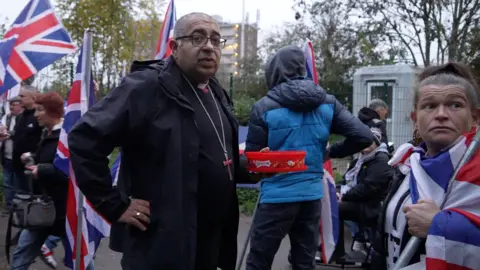The recent pivot among supporters of the controversial figure Tommy Robinson towards Christianity has placed the Church of England in a precarious position, raising questions about its role in a society rife with differing opinions on faith, identity, and immigration. Robinson, whose real name is Stephen Yaxley-Lennon, has characterized himself as a protector of Christian values, particularly during a rally held in September that showcased thousands of attendees expressing their newfound Christian commitments through symbolic displays. This phenomenon illustrates a growing trend among certain segments of the population who, driven by fears surrounding cultural and religious changes, have begun aligning their identity more visibly with Christian traditions and practices.
One of the notable participants in this shift is Gareth Talbot, a 36-year-old from Bradford. Despite not fully adhering to religious beliefs, Gareth felt compelled to attend church after he participated in one of Robinson’s rallies. He expressed feelings of urgency regarding preserving what he perceives as threatened Christian values, particularly in response to rising Islam and changes to cultural celebrations, like the rebranding of Christmas markets to “festive markets.” Gareth’s return to the church reflects a broader movement among individuals influenced by Robinson’s rhetoric, asserting a need for Christianity as a bastion of British values and freedoms, regardless of personal beliefs about the existence of a deity.
This burgeoning movement has forced the Church of England to confront critical challenges: How can it welcome new adherents while simultaneously navigating the tensions that arise from their positions? The church has a long history of promoting inclusivity and interfaith dialogue, yet the rise of Robinson’s supporters poses a complex dilemma. Two fundamental questions arise: How can the Church reconcile the beliefs of new congregants with a commitment to fostering understanding across diverse faiths? And how can it address misinterpretations of Christian values without alienating those who feel a genuine connection to these beliefs?
Upon his return to his childhood parish, Gareth met with Reverend Derek Jones, who represented this awakening tension within the church. Reverend Jones has approached his conversations with Gareth through a lens of openness, seeking to understand what values Gareth associates with Christianity and how they could promote inclusivity. He noted that while outreach is vital for the church, there must be caution exercised concerning the ideologies being embraced by some of these new congregants.
Furthermore, this situation has caused considerable discomfort among established Christian leaders. In a collective response, several bishops from the Church of England publicly condemned what they perceived as a co-opting of Christian symbols by Robinson’s movement, expressing that such actions undermine the inclusive essence of Christianity. They reminded followers that the core of the Christian message centers on unconditional love and support for all, emphasizing the need to represent Jesus Christ as a figure advocating for marginalized voices, including migrants and other vulnerable populations.
Bishop Ceirion Dewar, a conservative figure within the Church, has pushed back against mainstream criticisms, asserting his right to foster a space for discussions around what he sees as urgent social concerns tied to faith. He has been vocal about defending a notion of Great Britain’s foundation on Christian principles and opposing what he sees as encroachments from contemporary ideologies that threaten these values. His participation in Robinson’s rallies reflects a divide within Christian perspectives on national identity and religious faith.
The implications of this societal shift extend beyond the church, as it also touches upon broader issues of migration and community cohesion. Individuals like Amir, a migrant who has faced hostility upon arriving in the UK, find solace in the support offered by church members, contrasting sharply with the anti-immigrant sentiments surrounding them. This portrayal of the Church as a sanctuary for those in need stands in stark opposition to the rising activism among segments of society concerned about preserving cultural identity.
As these dynamics unfold, figures like Bishop Arun Arora emphasize the importance of healthy dialogue amidst discord. He advocates for understanding rather than division, reaching out to both supporters and opponents of a particular view, demonstrating that the church can strive to embrace differences while upholding its foundational principles. The task at hand for the Church of England, amidst declining attendance and rising sectarianism, will be managing a balancing act—promoting inclusivity while honoring the tenets of Christianity that call for love and acceptance across the societal spectrum.











